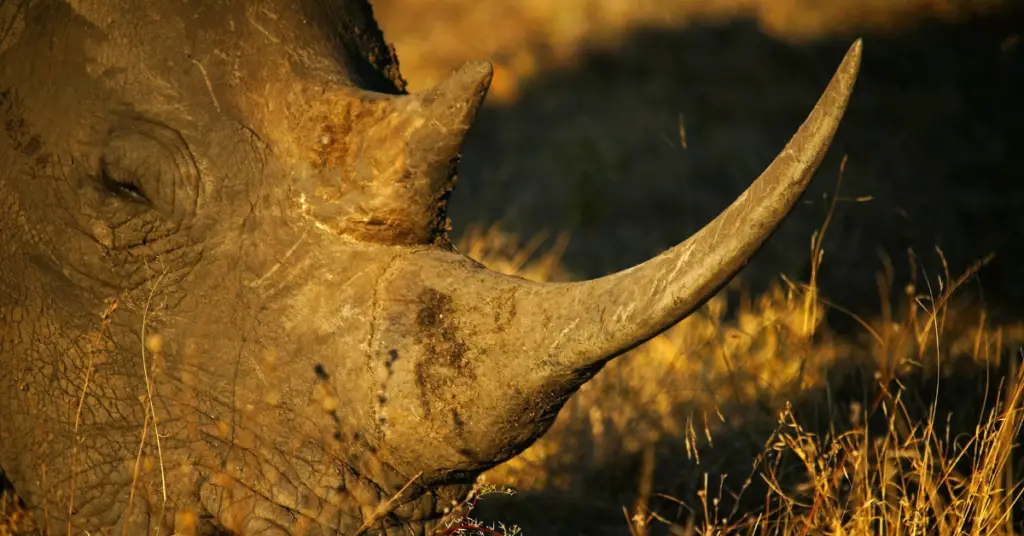Rhinoceroses are large-bodied, pachydermatous animals, endowed with one or two nasal horns consisting of aggregations of keratin fibers. The skin consists of a heavily keratinized and pigmented epidermis (about 1 mm thick) and a dense dermis (about 18-20 mm thick) composed of pure collagen fibers.
A covering of very sparse hairs is found in some individuals, especially when young. The White Rhinoceros Ceratotherium simum exceeds all other extant rhino species in size, with a body length reaching 4.2 m, a shoulder-height up to 1.9 m and weight of 3600 kg in adult males.
Two keratinous horns lacking a bony core grow in tandem on the muzzle, the anterior longer than the posterior. The horns are made upof a mass of tubular filaments similar in substance to hair and are actually outgrowths of the skin not attached to the bone of the skull.
The front horn of the white rhino has a straighter transverse border in front than that of the black rhinoceros. Male horns have a larger average anterobasal circumference than female horns, while female horns are more slender, and sometimes longer. Adult males have heavier horns than females.
The mean mass of horns of adult White Rhinos was 5.2 kg for the anterior horn and 1.9 kg for the posterior horn. No difference between adult sexes in intrinsic anterior horn growth(mean rate of 50 mm per year; range 25–66); the intrinsic horn growth rate is rapid in young animals, about 150 mm in the first year of life, but the growth rate of anterior horns decreases with age.
In a horn sample from KwaZulu–Natal and Kruger N. P., the mass of the anterior and posterior horns amounted to about 2.65 kg of horn per animal. The base of the anterior horn of the Black Rhino is circular in shape in contrast to the White Rhino, whose anterior horn has a squarish base. In general, black rhino horns are thinner than white rhino horns.
The intrinsic growth of the anterior horn is similar to that of the white rhinoceros determined by regrowing rates for dehorned Black Rhino at 60 mm and 27 mm per year for anterior and posterior horns, respectively; regrowth was faster in youngsters, at 89 mm and 44 mm per year, respectively.
The horns of the two African species are much larger than those of the three Asian species. The carbon and nitrogen sotopic ratios of rhinoceros horns differ between the two species, reflecting their different diets.
One of the most radical actions of biological conservation has been the removal of horns of black rhinos in an attempt to turn them into useless for poachers. The tactic had been debated in Kenya >10 years ago; it is still contested in Tanzania, and has been practiced and continues in three countries, Namibia, Zimbabwe, and Swaziland.
Two biological uncertainties exist: do horned individuals have advantages over hornless ones and are hornless mothers able to defend their young from dangerous carnivores.
Compared to the first, the question is generally controversial because dehorning operations target all animals in the same area.
The second problem is not; if the horns have defensive utility, then young hornless females maybe more susceptible to dangerous carnivores. More ongoing research will be able to answer these questions.

Erzsebet Frey (Eli Frey) is an ecologist and online entrepreneur with a Master of Science in Ecology from the University of Belgrade. Originally from Serbia, she has lived in Sri Lanka since 2017. Eli has worked internationally in countries like Oman, Brazil, Germany, and Sri Lanka. In 2018, she expanded into SEO and blogging, completing courses from UC Davis and Edinburgh. Eli has founded multiple websites focused on biology, ecology, environmental science, sustainable and simple living, and outdoor activities. She enjoys creating nature and simple living videos on YouTube and participates in speleology, diving, and hiking.

